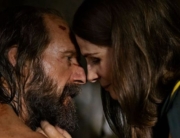![]() The Iraq War, to most Americans, is a distant memory, something from the early years of this century that doesn’t have much to do with our pressing national concerns, such as Russia-gate, the possible repeal of the Affordable Care Act, and the Syrian conflict. However, the aftermath of the 2003 invasion of Iraq is still very much present to the Iraqi civilians who have been struggling to rebuild their country, and their lives, to little avail. The title of this documentary captures the condition of the Iraqi people perfectly. The violence and chaos unleashed by the destruction of their country has only escalated and metastasized, and as the film makes evident, it is by no means clear that life will return to anything like normal any time soon.
The Iraq War, to most Americans, is a distant memory, something from the early years of this century that doesn’t have much to do with our pressing national concerns, such as Russia-gate, the possible repeal of the Affordable Care Act, and the Syrian conflict. However, the aftermath of the 2003 invasion of Iraq is still very much present to the Iraqi civilians who have been struggling to rebuild their country, and their lives, to little avail. The title of this documentary captures the condition of the Iraqi people perfectly. The violence and chaos unleashed by the destruction of their country has only escalated and metastasized, and as the film makes evident, it is by no means clear that life will return to anything like normal any time soon.
The film is perhaps the best document of the consequences of the war in Iraq, first called, with Orwellian flair, Operation Iraqi Freedom. It centers on Nori Sharif, a nurse in his mid-thirties with children, a wife, a nice house, a reliable, if tiny, car, and his most prized possession, a video camera. With his trusty camera, Nori chronicles the lives, deaths, joys, and miseries of his countrymen in ways that most Americans have not seen. He loves his work as a paramedic and nurse in his northern town of Jalawla, and we first join him in December 2011, when the American military officially withdrew from Iraq. This was a time of great hope for the Iraqi people, as, in their view, they were finally free of the occupiers after nearly a decade of having American tanks patrolling their streets.
His video project begins as a chronicle of his friends who had been maimed by American bombing during the war. Their injuries are hard to look at but necessary to fully understand the brutal violence that was rained down upon them. As the years pass, and 2011 becomes 2012 and 2012 becomes 2013, Nori ends up becoming as persecuted as the people he’s been nursing and filming. Savage, brutal, and senseless violence visits his once peaceful town in mid-2013, as young men are randomly kidnapped and beheaded. Nori and his friends discuss the violence and try to understand it, but they conclude that it is a runaway tornado, feeding on itself, without reason or motive.
In this context of growing senseless violence, the rise of the Islamic State (ISIS) in 2014 seems almost inevitable. ISIS is a death cult specializing in brutal beheadings, an organized group of psychotic killers, which is a natural outgrowth of the decade of bombing and chaos started by the invasion. With terrifying inevitability, ISIS makes its presence felt in Nori’s town, first with assaults on his ambulances, then by shooting up his hospital, until finally he is forced to pack his family into his tiny car and flee his beloved Jalawla.
Though morbid, gory, and without much hope, the film nevertheless reveals the incredible power of the human spirit to find joy and dignity in even the most depraved situations. Nori and his children smile as much as, indeed probably more than, the typical well-off American family, even as they flee from one refugee shelter to the next to avoid shelling. Though they escape across a sweltering desert, they always find time to smile, laugh, and even dance.
More than anything, Nowhere to Hide is a stirring reminder that millions of innocent Iraqi people have had their chance at a stable, secure life snatched away by the blundering chaos of the fighting. Their plight must not be forgotten.







Leave A Comment